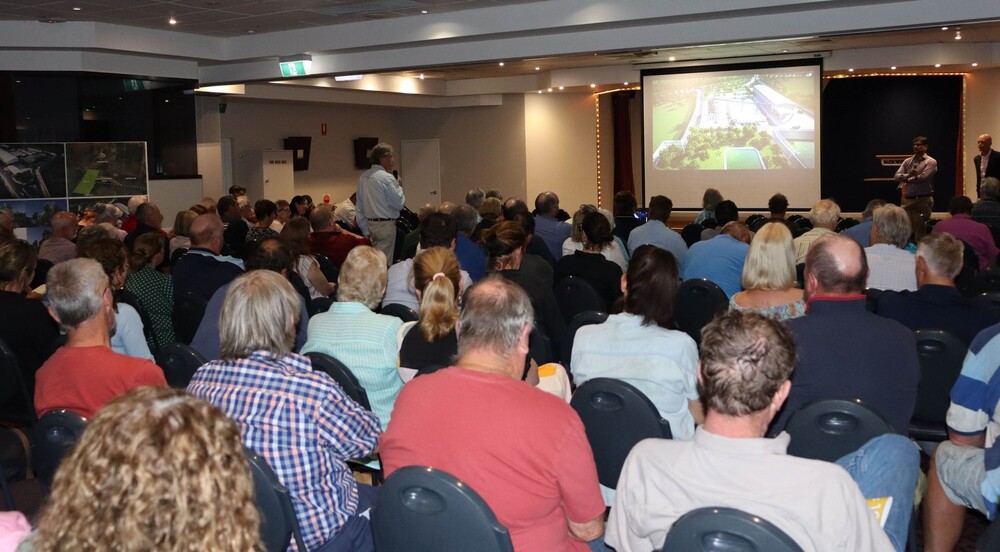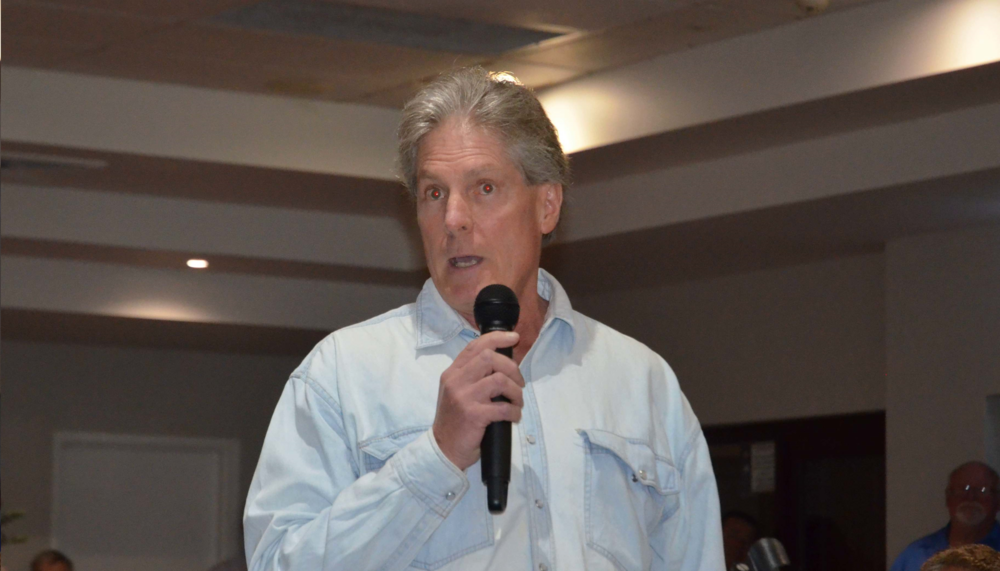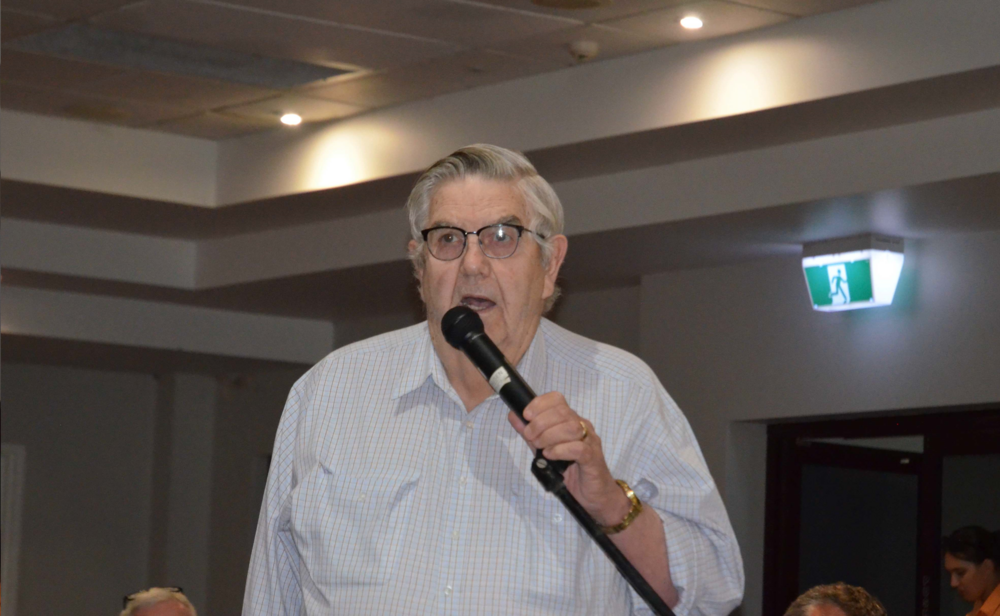Narwonah Renewables project "not a done deal"
Lyn Jablonski
08 December 2023, 2:40 AM
 Former Narromine shire councillor Bob Barnett takes his turn on the microphone at the public information session for the Narwonah Renewable Energy & Circular Chemicals Project. PHOTO SUPPLIED.
Former Narromine shire councillor Bob Barnett takes his turn on the microphone at the public information session for the Narwonah Renewable Energy & Circular Chemicals Project. PHOTO SUPPLIED.The Ballhausen Room at the Narromine United Services Memorial Club was packed for the second night in a row last week, with local residents turning out in record numbers to voice their views and find out more about a major project promising to deliver big benefits.
Asia Pacific Waste Solutions (APWS) held a second community information evening on Wednesday 29 November, regarding their Narwonah Renewable Energy and Circular Chemicals Project.
If state bodies approve, the facility will be constructed nine kilometres south of Narromine, at a site surrounded by up to thirteen rural properties.
The session aimed to provide more technical information and answer some of the many questions being raised by the local community.
“This (information session) is the beginning of the process," said Tracy Dingum, director of APWS. "We have a long way to go, and it is not a done deal.”
He said that the consultation process had just begun and he had ‘taken on board’ comments from the previous evening's session.
Speakers included representatives from a number of project partners including Aiden Stretch from Full Cycle Climate Partners Investment (a private equity fund); and Chani Lokuge,Technical Director with SLR Consulting, a company which supports clients through environmental and regulatory aspects of projects such as the one being proposed for Narromine.
They also referred to other companies, BurCell and Synova Technology, to be involved in delivering specific components of the operation.
Mr Lokuge described the facility as ‘an integrated resource recovery and energy-from-chemicals project’.
He explained that the processing of waste at the proposed facility involves two stages. The first is anaerobic digestion, which treats organics without oxygen to create a biogas.
“The biogas can be converted into energy or cleaned up and put into the natural gas,” Mr Lokuge said. “The plant could divert 50,000 to 70,000 tons of waste from going into landfills."
He also told the audience that there are ‘multiple reference plants across the globe have run successfully’, including one in Australia and one in New Zealand.
The second stage is referred to as thermal treatment or gasification.
“That is where we take feedstocks (waste), including plastics and green waste, and convert them into chemicals that can be used in plastics production off-site," Mr Lokuge told the audience. " This is equivalent to taking approximately 15,000 cars off the road concerning greenhouse gas benefits. The plant could produce 50,000 megawatt hours of energy to power 8,000 households.”
He spoke of the expected regional and local benefits for Narromine. “During the construction, there will be 250 direct jobs, 150 direct jobs during the operational stage and 200 indirect jobs from the development of this facility.”
A long way to go to meet 'the pub test'
In response to community concerns that the proposal would be a 'waste incinerator' and that dioxins would be emitted, all speakers repeatedly stated that the facility was not an incinerator.
“Firstly, it is not an incinerator; nothing gets burned," Mr Dignum said. “Converting solids to gas does not involve incineration,” he said. “It basically uses steam to separate the organic or biogenic material in the waste into a separate stream, which then goes to the anaerobic digestion process to make the renewable natural gas and power."

There was a packed house at both public information sessions on the Narwonah Renewables & Circular Chemicals Project in Narromine last week. PHOTO SUPPLIED.
However this aspect of the project continues to be heavily scrutinised.
Local community member Bruce Maynard emphatically reiterated his understanding that the second phase does meet international definitions of what is considered an 'incineration plant'.
Mr Dignum also explained that the process to be provided by Synova Technology can use a lot of different types of waste, including plastics, municipal waste and even biomass waste.
Another audience member questioned the carbon footprint for "importing other people's garbage from Brisbane and Melbourne".
“It is a statutory requirement, as part of the approval process, to do a full lifecycle analysis which incorporates transport of the waste, looking at the emissions, and the processing of the waste disposal of the residue,” Mr Lokuge said.

Narromine resident Andrew Knopp raised a number of questions at the community information session on Wednesday.
There was a question regarding the release of dioxins - or persistent environmental pollutants. “This will be monitored along with PFAS,” Mr Stretch said. [Note: PFAS are 'per- and polyfluoroalkyl substances', a group of chemicals used in many applications from paper coating to cosmetics and aviation hydraulic fluid. They are known as 'forever chemicals' for their long lasting properties.]
“Given the scale of this project ... the community has widespread concern about the impact it will make on our town, the smell, potential contamination of aquifers and the facility being on a floodplain," said local resident Andrew Knopp.
Speaker Aidan Stretch (Full Cycle Climate Partners Investment) responded that “There is no smell. With the BurCell technology, when the waste comes in, it goes straight into the system to be sterilised with steam.”
Regarding many of Mr Knopp's concerns, Mr Dignum said, “I think, sir, you are actually jumping the gun a little bit. All those (environmental concerns) will be dealt with under the EIA (Environmental Impact Assessment) process. We have come here to tell you what we are looking at, and what we are considering doing.”
He said that once the EIA is drafted it will be available to everyone in the room. “We just can't give you all the answers tonight.”
APWS representatives say they are taking concerns on board and will address them as part of the approval process. “You will see the lifecycle assessment of the project, and you can question that,” he said.
Mr Knopp also questioned the ownership of the land and the local interests involved, along with questions about the track record of project partners to complete large-scale projects of this type.
Community continue to look for answers
Local farmer Vicky Gainsford, said she attended the previous meeting but felt she needed to do some of her own research to get a grip on the project.
“I did not find all the information that everyone else had found particular to your project,” she said.
Mrs Gainsford said she looked up ‘chemical recycling’ and found information regarding Europe rather than Australia.
Mrs Gainsford said she believes ‘chemical recycling has an overall lower carbon footprint compared to today's end of life practices’ and it is a local, Australian and global problem.
“I can see you are trying to solve a problem,” she said. But she has concerns about leaching harmful chemicals into the air and soil.

Local resident Rolly McDonald was one of the many community members to speak at the information session.
Ex-Narromine Shire Councillor, Bob Barnett, said that he believed that Council made a major error in not involving the community in this process before inviting APWS along to make this presentation.
“I think if the Council had involved the community earlier they would have got a pretty good vibe of how the community felt,” he said.
Mayor Craig Davies responded that "six months ago, we would not have had the detail that is currently available nor did I have the understanding that these experts have.”
“The Narromine Shire council has given these people (APWS) permission to undergo a study, nothing more, nothing less,” said Cr Davies. “They now need to get a very comprehensive study done by the EPA and other government departments. Let them (APWS) bring that to the community and let them decide.”
Cr Davies said that this project is about job opportunities, housing in Narromine and kids getting better jobs locally.
Narromine resident Rolly McDonald said he had lived in Narromine for 72 years. He said he believed that the audience was ‘frightened and emotional’ because they did not know what they were facing.
“There are two sides to everything; things have to evolve, and we have to look to the future,” he said. “If we deny this (APWS project) and it goes to Gilgandra, Parkes or somewhere and turns out to be the second greatest thing since sliced bread, we have missed an opportunity.”
“Council does not have this decision. It will be made on the enormity of the project by state bodies,” Mr McDonald said.
Editor's note:
Our reporter Lyn Jablonski is a former Councillor of the Narromine Shire Council. She retired at the end of June 2023. During her time on Council, she was not privy to any official information regarding APWS.



